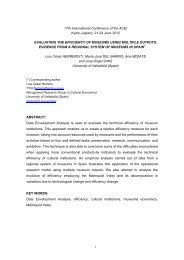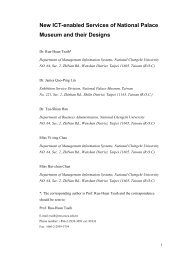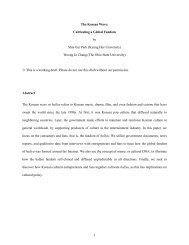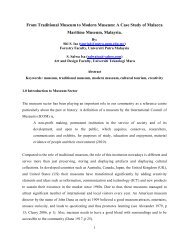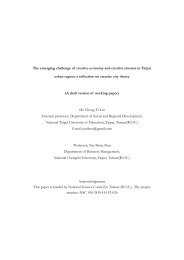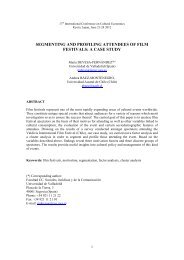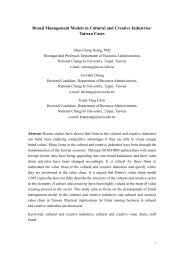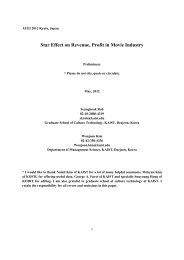cultural tourism and crafts as part of the development of a region
cultural tourism and crafts as part of the development of a region
cultural tourism and crafts as part of the development of a region
Create successful ePaper yourself
Turn your PDF publications into a flip-book with our unique Google optimized e-Paper software.
CULTURAL TOURISM AND CRAFTS AS<br />
PART OF THE DEVELOPMENT OF A<br />
REGION<br />
ABOUT CRAFTS, ECONOMIC DEVELOPMENT AND HERITAGE<br />
Craft production h<strong>as</strong> great importance in <strong>the</strong> economic <strong>development</strong> <strong>of</strong> a<br />
country, being a source <strong>of</strong> direct <strong>and</strong> indirect employment. This contributes to<br />
social <strong>development</strong>, preventing migration to urban are<strong>as</strong>, <strong>as</strong> it becomes a<br />
barrier against violence <strong>and</strong> promotes women's empowerment. For its<br />
characteristics, in recent years, it h<strong>as</strong> become extremely important for <strong>the</strong><br />
<strong>development</strong> <strong>of</strong> projects that promote this sector in public <strong>and</strong> private<br />
institutions.<br />
Craft h<strong>as</strong> become valuable <strong>as</strong> <strong>part</strong> <strong>of</strong> <strong>the</strong> living heritage <strong>of</strong> a <strong>region</strong> <strong>and</strong><br />
undoubtedly it h<strong>as</strong> a significant connection when we talk about <strong>cultural</strong> <strong>tourism</strong>.<br />
Each country h<strong>as</strong> developed policies to improve craft production chains. Special<br />
priority is given to marketing, in order to revitalize <strong>the</strong> sector, opening up<br />
possibilities for improving <strong>the</strong> living conditions <strong>of</strong> <strong>the</strong> artisans producers. We<br />
should mention, especially, <strong>the</strong> actions that link <strong>the</strong> different chains <strong>of</strong> craft with<br />
<strong>tourism</strong>.<br />
When we talk about <strong>crafts</strong> differentiation is <strong>the</strong> most important factor for<br />
commercialization <strong>and</strong> it’s me<strong>as</strong>ured in function <strong>of</strong> its limited availability or, <strong>the</strong><br />
notion that <strong>the</strong>y are unique items, so-called "Articles hard-to-find”.<br />
Many <strong>of</strong> <strong>the</strong> objects from craft market use creativity <strong>as</strong> a <strong>development</strong> strategy<br />
<strong>and</strong> are <strong>part</strong> <strong>of</strong> a natural expression, <strong>the</strong> need <strong>and</strong> desire <strong>of</strong> men <strong>as</strong> individuals.<br />
So craft can show us <strong>the</strong> character <strong>and</strong> identity <strong>of</strong> a nation or an individual<br />
(<strong>crafts</strong>man).<br />
Craft is created by marketing. It’s <strong>part</strong> <strong>of</strong> a process in which <strong>the</strong> traditional<br />
objects are filled with elements for its transformation <strong>and</strong> adaptation. At <strong>the</strong><br />
same time, <strong>the</strong> product <strong>and</strong> <strong>the</strong> <strong>of</strong>fice production chain were transformed to be<br />
adapted to <strong>the</strong> market. It is a two way street with feedback where folklore is <strong>the</strong><br />
protagonist.<br />
It is difficult to establish a clear definition <strong>of</strong> what a folkloric product is. There are<br />
many items like antiquity, tradition, or <strong>the</strong> fact <strong>of</strong> being a reflection or a sign <strong>of</strong><br />
identity in a community, among <strong>the</strong> o<strong>the</strong>rs. In this way traditional craft products<br />
that preserve ancestral forms <strong>and</strong> use <strong>the</strong>m to legitimate <strong>the</strong> new creations <strong>of</strong><br />
1
<strong>crafts</strong>man reflect <strong>the</strong>ir interaction with <strong>the</strong> environment, <strong>and</strong> with different<br />
markets <strong>and</strong> users.<br />
We can conceive craft from three dimensions:<br />
• Craftsman: <strong>as</strong> a designer <strong>and</strong> <strong>as</strong> a builder <strong>of</strong> culture.<br />
• Craft activity: As an action that applies traditional <strong>and</strong> / or contemporary<br />
artisan techniques <strong>and</strong> practices; <strong>and</strong> <strong>as</strong> a production process that provides<br />
livelihood to (<strong>the</strong>) <strong>crafts</strong>man.<br />
• Craft products: <strong>as</strong> an expression <strong>of</strong> identity in national, <strong>region</strong>al <strong>and</strong> local<br />
levels.<br />
Craft concept h<strong>as</strong> been developed in different ways along history <strong>and</strong> it h<strong>as</strong><br />
taken different conceptualizations. Today, its definition is still heterogeneous<br />
<strong>and</strong> can be analyzed from different perspectives.<br />
At <strong>the</strong> international level, UNESCO defines it <strong>as</strong>: "Artisanal products are<br />
produced by artisans, predominantly made by h<strong>and</strong>, or with h<strong>and</strong> tools, or even<br />
with <strong>the</strong> help <strong>of</strong> mechanical tools. The direct manual contribution <strong>of</strong> <strong>the</strong> artisan<br />
must be <strong>the</strong> most important component <strong>of</strong> <strong>the</strong> finished product. They are<br />
produced without restriction in terms <strong>of</strong> quantity <strong>and</strong> using raw materials from<br />
sustainable resources. The special nature <strong>of</strong> artisanal products derives from<br />
<strong>the</strong>ir distinctive characteristics, in which you can include factors like, being<br />
utilitarian, aes<strong>the</strong>tic, artistic, creative, connected with culture, decorative,<br />
functional, traditional, or being symbolic <strong>and</strong> significant in religion or society.<br />
"(UNESCO 1997)<br />
This definition is very extensive. In first place, craft categories are not defined,<br />
The definition emph<strong>as</strong>izes in <strong>the</strong> preponderance <strong>of</strong> h<strong>and</strong>work <strong>and</strong> <strong>the</strong> different<br />
uses that can have a product. Putting in a second place <strong>the</strong> "traditional"<br />
heritage, perceiving <strong>the</strong> characteristics <strong>of</strong> transformation <strong>and</strong> adaptation that <strong>the</strong><br />
traditional product h<strong>as</strong>, but it does not engage any statement. According to this<br />
definition any product made mostly by h<strong>and</strong> can be considered a craft product. I<br />
do not agree entirely, because we must consider factors like culture, history,<br />
geography <strong>and</strong> o<strong>the</strong>r <strong>as</strong>pects <strong>of</strong> <strong>the</strong> <strong>development</strong> <strong>of</strong> a group.<br />
We can say that craft is created from <strong>the</strong> "traditional" products, taking elements<br />
from outside to its tradition; <strong>as</strong>pects that make <strong>the</strong> identity <strong>of</strong> individuals <strong>and</strong><br />
groups, involved in a globalized world.<br />
In conclusion, we can underst<strong>and</strong> craft <strong>as</strong> <strong>the</strong> production <strong>of</strong> local objects that<br />
enter in market dynamics. Marked by manual production <strong>and</strong> use <strong>of</strong> natural<br />
materials prevails, characterized by <strong>the</strong> use <strong>of</strong> techniques transmitted by<br />
tradition <strong>and</strong> forms <strong>of</strong> creation that include artistic, aes<strong>the</strong>tic, <strong>cultural</strong>, <strong>and</strong><br />
morphological elements, <strong>the</strong> use <strong>and</strong> significance, related to <strong>the</strong> experiences <strong>of</strong><br />
2
<strong>crafts</strong>man by tradition or evolution. These products can be considered an<br />
expression <strong>of</strong> identity <strong>and</strong> national culture. Their production is influenced by<br />
historical, geographical <strong>and</strong> <strong>cultural</strong> contexts where <strong>the</strong>y occur <strong>and</strong> by foreign<br />
elements derived from outside groups.<br />
Crafts show <strong>the</strong> process <strong>of</strong> social construction <strong>of</strong> heritage, <strong>and</strong> <strong>the</strong>ir production<br />
<strong>and</strong> technological processes are <strong>as</strong>sociated with <strong>the</strong> practices <strong>of</strong> <strong>the</strong> everyday<br />
life.<br />
UNESCO recognizes (<strong>the</strong>) craft <strong>as</strong> one <strong>of</strong> <strong>the</strong> forms <strong>as</strong>sumed by traditional <strong>and</strong><br />
popular culture to represent <strong>the</strong> creative activity <strong>of</strong> a community .lt also<br />
recognizes that <strong>the</strong>y are b<strong>as</strong>ed on tradition, being an expression <strong>of</strong> <strong>cultural</strong> <strong>and</strong><br />
social identity.<br />
Government policies around <strong>the</strong> craft have two fundamental sides, being <strong>the</strong><br />
first <strong>of</strong> economic <strong>development</strong> <strong>and</strong> <strong>the</strong> second, where <strong>the</strong> craft is understood <strong>as</strong><br />
<strong>the</strong> nation's <strong>cultural</strong> heritage.<br />
The current economic system in which craft production is involved requires<br />
taking into account local society producers <strong>and</strong> <strong>the</strong> requirements dem<strong>and</strong>ed by<br />
<strong>the</strong> market. The studies developed in this area should be directed to find a<br />
balance between <strong>the</strong> tradition <strong>of</strong> craft <strong>and</strong> its commercialization in large or small<br />
scales, trying to minimize <strong>the</strong> negative impacts on social, <strong>cultural</strong>, physical or<br />
economic <strong>as</strong>pects.<br />
The only way to underst<strong>and</strong> craft production <strong>as</strong> a tangible <strong>and</strong> intangible<br />
heritage <strong>of</strong> humanity is approaching to <strong>the</strong> artisan communities to observe its<br />
production <strong>as</strong> a result <strong>of</strong> a society in a constant state <strong>of</strong> change <strong>and</strong> at <strong>the</strong> same<br />
time decode <strong>the</strong> interrelation with o<strong>the</strong>r components like changes in<br />
environment, <strong>and</strong> production methods, marketing, communications, advertising<br />
<strong>and</strong> commercialization.<br />
It is necessary to interpret <strong>the</strong> human being in <strong>the</strong> environment where h<strong>as</strong> been<br />
developed. Only in this way we will be able to plan a series <strong>of</strong> actions related to<br />
<strong>the</strong> use <strong>of</strong> craft heritage, for commercial purposes or for purposes related to<br />
<strong>cultural</strong> <strong>tourism</strong>, without affecting to <strong>the</strong> normal <strong>development</strong> <strong>of</strong> <strong>the</strong> artisan<br />
community.<br />
THE TOURISTIC ATTRACTION OF CRAFT PRODUCTION<br />
Inside <strong>the</strong> network <strong>of</strong> relations established between artisans <strong>and</strong> buyers, it is<br />
necessary to consider <strong>the</strong> attraction that certain <strong>as</strong>pects <strong>of</strong> <strong>the</strong> culture <strong>of</strong> <strong>the</strong><br />
first group can cause. Essentially tangible elements <strong>of</strong> craft like color, form,<br />
design, material, type <strong>of</strong> production, <strong>and</strong> all those o<strong>the</strong>rs components that can<br />
seem attractive to tourists whose interests are related to culture. I am referring<br />
3
to those signs <strong>of</strong> identity <strong>of</strong> craft product, specific from every <strong>region</strong>, which can<br />
be e<strong>as</strong>ily captured by buyers or sellers <strong>and</strong> are used <strong>as</strong> a claim to motivate a<br />
purch<strong>as</strong>e. This shows <strong>the</strong> idea that craft can reinforce <strong>the</strong> memory <strong>of</strong> a trip, or<br />
become an economic <strong>and</strong> ideological support <strong>of</strong> a community or environment.<br />
In our Western society, only <strong>the</strong> factors that are advertised properly can arrive<br />
to a wide range <strong>of</strong> public. In <strong>the</strong> c<strong>as</strong>e <strong>of</strong> craft, only a few site-specific products,<br />
due to <strong>the</strong>ir exoticism or touristic success, can be e<strong>as</strong>ily promoted. But we<br />
must consider that a h<strong>and</strong>icraft production contains elements that configure<br />
<strong>the</strong>ir distinctive heritage identity <strong>and</strong> that <strong>the</strong>re are groups <strong>and</strong> institutions that<br />
are conscious <strong>of</strong> <strong>the</strong>ir value, want <strong>the</strong>ir conservation <strong>and</strong> projection; both <strong>the</strong><br />
members <strong>of</strong> <strong>the</strong> community <strong>and</strong> outsiders.<br />
The visitor is looking for a place not only for resting, a good <strong>part</strong> want to<br />
<strong>part</strong>icipate in <strong>cultural</strong> activities. In this sense, museums, historic monuments<br />
<strong>and</strong> natural parks st<strong>and</strong> out in applications for tourists, <strong>as</strong> places <strong>of</strong> interest that<br />
cover <strong>the</strong>se needs. Today, <strong>crafts</strong> <strong>as</strong> a product <strong>and</strong> its surroundings; workplace,<br />
artisans, techniques, have become a claim for <strong>the</strong> visitors <strong>of</strong> a place.<br />
The fact that a tourist knows <strong>the</strong> <strong>cultural</strong> heritage <strong>of</strong> a <strong>region</strong> can be highly<br />
positive, if in addition it will <strong>of</strong>fer a series <strong>of</strong> actions that promote <strong>the</strong> <strong>as</strong>similation<br />
<strong>of</strong> that heritage. In this way, we get, first, that tourist people underst<strong>and</strong> some<br />
<strong>as</strong>pects <strong>of</strong> <strong>the</strong> identity <strong>of</strong> <strong>the</strong>ir hosts, <strong>and</strong> on <strong>the</strong> o<strong>the</strong>r h<strong>and</strong>, that artisans<br />
become interested in preserving <strong>and</strong> activating elements that in o<strong>the</strong>r<br />
circumstances could be relegated.<br />
We should not take an extreme position considering that, only through <strong>tourism</strong>,<br />
<strong>crafts</strong> can be recovered <strong>as</strong> Patrimony (because <strong>the</strong> responsibility <strong>of</strong> keeping<br />
alive a craft concerns to <strong>the</strong> producer community), but it is necessary to affirm<br />
that <strong>tourism</strong> is useful in <strong>the</strong> re search for this purpose.<br />
Each community, by itself, needs to work to inventory, catalog, preserve,<br />
transmit <strong>and</strong> activate its own heritage. This decision should depend exclusively<br />
on <strong>the</strong> members <strong>of</strong> each group, <strong>and</strong> can be implemented with financial support<br />
from private or public institutions <strong>and</strong> companies.<br />
A place can be known through its heritage elements into which <strong>the</strong> craft h<strong>as</strong> an<br />
important role, so <strong>the</strong> tourists will take <strong>the</strong> image that his hosts <strong>of</strong>fer <strong>and</strong> this will<br />
provide an economic benefit <strong>and</strong> serve to reinforce <strong>the</strong> esteem about <strong>the</strong><br />
community identity factors.<br />
POPULAR CULTURE AND HERITAGE<br />
Culture includes <strong>the</strong> tangible <strong>and</strong> intangible production, all <strong>the</strong> creative <strong>as</strong>pects,<br />
social networks, religion <strong>and</strong> ideology, that are manifestations <strong>of</strong> human beings.<br />
4
We also have to take into account <strong>the</strong> continuous processes <strong>of</strong> change,<br />
characteristic <strong>of</strong> society.<br />
Cultural heritage is what differentiates individuals belonging to different ethnic<br />
groups, in this definition we can include architecture, legends, historical texts,<br />
music, poetry, clothing, <strong>crafts</strong>, <strong>and</strong> <strong>the</strong> knowledge about ways to produce,<br />
among o<strong>the</strong>rs.<br />
These manifestations must be recognized <strong>as</strong> <strong>the</strong>ir own by <strong>the</strong> groups in order to<br />
be considered <strong>cultural</strong> heritage. So, although <strong>the</strong> heritage is built continuously, it<br />
is not defined until it h<strong>as</strong> been incorporated into <strong>the</strong> lifestyles <strong>of</strong> <strong>the</strong> group.<br />
Both traditional <strong>and</strong> new <strong>as</strong>pects are <strong>part</strong> <strong>of</strong> <strong>the</strong> heritage creation. That is<br />
culture. Considering only <strong>the</strong> old features <strong>as</strong> likely to be preserved <strong>and</strong><br />
disseminated, is denying <strong>the</strong> evolutionary processes <strong>of</strong> individuals <strong>and</strong><br />
<strong>the</strong>refore, <strong>the</strong> logical creations motivated by <strong>cultural</strong> changes.<br />
Cultures <strong>and</strong> <strong>the</strong>ir expressions are alive <strong>and</strong> are being built. Craft is no stranger<br />
to this phenomenon, <strong>as</strong> it is <strong>the</strong> product <strong>of</strong> a culture, so craft is affected by <strong>the</strong>ir<br />
interaction (especially for marketing <strong>and</strong> <strong>tourism</strong>). This fact made many artisan<br />
groups modify <strong>as</strong>pects <strong>of</strong> <strong>the</strong>ir cultures.<br />
To underst<strong>and</strong> processes or artisanal products, modified in accordance to<br />
<strong>tourism</strong>, we need to investigate how its inhabitants have adapted to new social<br />
forms <strong>and</strong> how that relationship h<strong>as</strong> led individuals to know <strong>the</strong>ir own heritage.<br />
Today, many tourist destinations have decided to <strong>of</strong>fer specific <strong>cultural</strong> <strong>as</strong>pects.<br />
The benefits obtained through <strong>tourism</strong> can be managed from different positions:<br />
economic, social, <strong>cultural</strong>, etc., for tourists <strong>and</strong> local people.<br />
CULTURAL TOURISM<br />
Tourism always had a <strong>cultural</strong> <strong>as</strong>pect. Many <strong>of</strong> <strong>the</strong> trips that have been made<br />
throughout history were motivated by <strong>the</strong> interest <strong>of</strong> visiting places in which you<br />
could find artistic manifestations or historical interest. As <strong>part</strong> <strong>of</strong> <strong>the</strong> motivations<br />
for <strong>tourism</strong>, we can find, interest in learning about groups <strong>of</strong> individuals from <strong>the</strong><br />
so-called "o<strong>the</strong>r cultures" or "exotic cultures". Travel, see o<strong>the</strong>r places <strong>and</strong> meet<br />
o<strong>the</strong>r individuals, helped to disseminate elements pertaining to <strong>the</strong> lifestyles <strong>of</strong><br />
both.<br />
In <strong>the</strong>se early days, <strong>the</strong> systems transmission <strong>of</strong> information were slow. In fact<br />
only a few persons were involved in <strong>the</strong> activity <strong>and</strong> generally kept <strong>the</strong> distance<br />
between autochthonous groups <strong>and</strong> visitors.<br />
5
It w<strong>as</strong> in <strong>the</strong> twentieth century when <strong>tourism</strong> began to link to heritage <strong>as</strong> a way<br />
to affirm <strong>the</strong> own identity. At <strong>the</strong> same time, states have just begun to<br />
underst<strong>and</strong> <strong>the</strong>ir role in <strong>the</strong> <strong>development</strong> <strong>of</strong> <strong>cultural</strong> <strong>tourism</strong>. All this will make<br />
possible that patrimony acquires an important economic role <strong>and</strong> <strong>cultural</strong><br />
<strong>tourism</strong> is beginning to be considered essential in <strong>the</strong> presentation <strong>of</strong> tourist<br />
<strong>of</strong>fers for visitors.<br />
Today when we talk about <strong>cultural</strong> <strong>tourism</strong> we are referring to something more<br />
specific such concrete interests that some tourists have in visiting certain<br />
places. Included inside <strong>the</strong> alternative <strong>tourism</strong>, in which o<strong>the</strong>r possibilities are<br />
<strong>of</strong>fered outside <strong>the</strong> rest in a place more or less beautiful with an attractive<br />
climate.<br />
Cultural <strong>tourism</strong> is defined by <strong>the</strong> International Labour Organisation <strong>as</strong> <strong>the</strong><br />
possibility that people have to tap into <strong>the</strong> natural history, human <strong>and</strong> <strong>cultural</strong><br />
heritage, arts <strong>and</strong> philosophy, <strong>and</strong> institutions <strong>of</strong> o<strong>the</strong>r countries or <strong>region</strong>s.<br />
Those who usually practice <strong>cultural</strong> <strong>tourism</strong> consume <strong>as</strong>pects <strong>of</strong> <strong>the</strong> heritage <strong>of</strong><br />
a <strong>part</strong>icular location with <strong>the</strong> intention, presumably, to underst<strong>and</strong> <strong>the</strong> place <strong>and</strong><br />
those who live or lived in it. And this should be done through <strong>the</strong> use <strong>of</strong> images<br />
displayed on <strong>the</strong> site <strong>and</strong> additional information obtained by writing brochures<br />
<strong>and</strong> manuals, tourist guides, documentaries, among o<strong>the</strong>rs, <strong>and</strong> also through<br />
contact with <strong>the</strong> hosts.<br />
We can distinguish three types <strong>of</strong> <strong>cultural</strong> tourists (Greffe, 1999 pág. 15)<br />
(Hernández Hernández, 1998 pág. 379):<br />
1. The "experts", who are those who travel regularly <strong>and</strong> systematically.<br />
There is usually a relationship between <strong>the</strong>ir work <strong>and</strong> <strong>the</strong> touristic<br />
practices <strong>the</strong>y perform. This represents between 10 <strong>and</strong> 15% <strong>of</strong> visitors.<br />
2. "highly motivated" tourists. Although <strong>the</strong>re are o<strong>the</strong>r causes for <strong>the</strong>ir<br />
holiday trip, <strong>the</strong> main cause is culture. This group constitutes over a 30<br />
or a 40% <strong>of</strong> <strong>the</strong> visitors.<br />
3. "Occ<strong>as</strong>ional" tourists. That is a group that includes all those tourists that<br />
on vacation develop <strong>cultural</strong> activities irregularly, scrolling a maximum <strong>of</strong><br />
50 Kilometers. They represent between 45 <strong>and</strong> 60% <strong>of</strong> visitors.<br />
Obviously, <strong>the</strong>se tourists will have different behavior in <strong>the</strong> moment <strong>of</strong><br />
visiting <strong>cultural</strong> heritage. Those cl<strong>as</strong>sified <strong>as</strong> "experts" <strong>and</strong> many <strong>of</strong> <strong>the</strong><br />
"highly motivated", previously usually report what <strong>the</strong>y will see, so <strong>the</strong>y will<br />
underst<strong>and</strong> <strong>the</strong> aes<strong>the</strong>tic, historic, artistic, etc. <strong>of</strong> <strong>the</strong> visited place. Prior<br />
knowledge <strong>of</strong> heritage, <strong>and</strong> <strong>the</strong>ir sensitivity to it, will encourage an attitude <strong>of</strong><br />
respect. However, <strong>the</strong> feeling to individuals that produce or have produced<br />
<strong>the</strong>se <strong>cultural</strong> manifestations, is not always appreciated.<br />
6
In addition, most <strong>of</strong> <strong>the</strong> visitors that are from <strong>the</strong> third group <strong>of</strong> <strong>the</strong><br />
cl<strong>as</strong>sification presented: those who come, so "c<strong>as</strong>ual", to <strong>the</strong> places <strong>of</strong><br />
<strong>cultural</strong> interest just <strong>as</strong> an alternative to a vacation planned for o<strong>the</strong>r<br />
purposes; have little or no information about <strong>the</strong> places or have little interest<br />
in enjoying <strong>the</strong>m. Their visit is ano<strong>the</strong>r activity to achieve an end: to enjoy a<br />
ple<strong>as</strong>ant holiday, ideally, different. Therefore, if <strong>the</strong> heritage interest does<br />
not exist, <strong>the</strong>y can not worry about its meaning, value <strong>and</strong>, <strong>of</strong> course, <strong>the</strong>y<br />
will not worth <strong>the</strong>ir respect.<br />
TOURISM AND CULTURAL CHANGE<br />
In <strong>the</strong> relations established between <strong>the</strong> tourist <strong>and</strong> local resident, <strong>the</strong>re is a<br />
transfer <strong>of</strong> <strong>cultural</strong> elements. This exchange may be beneficial or detrimental, it<br />
is a process <strong>of</strong> acculturation, situation that occurs when two or more groups<br />
with different ethnic identities, coexist in <strong>the</strong> same physical space; in <strong>the</strong>se<br />
c<strong>as</strong>es certain <strong>cultural</strong> elements p<strong>as</strong>s, <strong>as</strong> a loan from one society to ano<strong>the</strong>r,<br />
ei<strong>the</strong>r mutually or with <strong>the</strong> subordination <strong>of</strong> one <strong>of</strong> <strong>the</strong>m.<br />
In many places diverse heritage elements are changing in terms <strong>of</strong> <strong>tourism</strong>. We<br />
have an example in <strong>the</strong> restoration <strong>of</strong> old urban are<strong>as</strong>, being a clear evidence <strong>of</strong><br />
heritage directed activation generally made, to cover <strong>tourism</strong> <strong>of</strong>ferings, some <strong>of</strong><br />
<strong>the</strong>se projects do not produce <strong>the</strong> expected results.<br />
We also found that <strong>the</strong> implementation <strong>of</strong> numerous <strong>cultural</strong> programs to <strong>the</strong><br />
<strong>tourism</strong> sector do not get <strong>the</strong> desired effect. But good planning <strong>and</strong> political will<br />
achieve activation <strong>of</strong> urban spaces, symbolic monuments, dances, traditional<br />
songs, <strong>crafts</strong>, etc.<br />
The activation <strong>of</strong> certain patrimonial elements <strong>as</strong> <strong>crafts</strong>, with only touristic<br />
purposes would result in structural changes in <strong>the</strong> product, modifying <strong>the</strong><br />
manufacturing process, transforming <strong>crafts</strong> to industrial products or in seriate,<br />
which could lead to its rejection.<br />
The object made using traditional methods, fundamentally h<strong>and</strong>made <strong>and</strong><br />
excluded from industrial processes, is loaded with <strong>cultural</strong> characteristics <strong>of</strong><br />
exclusivity. By introducing <strong>the</strong> craft in <strong>the</strong> commercial dynamics <strong>of</strong> <strong>the</strong> <strong>tourism</strong><br />
chain, <strong>the</strong> object is transformed <strong>and</strong> consequently in some c<strong>as</strong>es may lose <strong>the</strong>ir<br />
traditional role by acquiring new meanings for both producing society <strong>and</strong> to <strong>the</strong><br />
receiver.<br />
For example if we take a ceramic bowl initially developed for everyday use in a<br />
community, this object can be transformed into "a souvenir" for tourists,<br />
changing <strong>the</strong>ir use <strong>and</strong> meaning. The concept <strong>of</strong> h<strong>and</strong>icraft product, is<br />
transformed. This conclusion is b<strong>as</strong>ed on <strong>the</strong> idea that anthropological heritage<br />
7
is a living set <strong>of</strong> identifying features <strong>of</strong> a society (<strong>cultural</strong> elements in permanent<br />
transformation) . We're talking about culture <strong>and</strong> culture is built every day.<br />
By working with <strong>tourism</strong> societies that, logically, establish ongoing relationships<br />
with outside groups, we notice that <strong>cultural</strong> change processes are usually rapid.<br />
The approach to <strong>tourism</strong> in its economic <strong>and</strong> industrial <strong>as</strong>pects, brings this<br />
market relationship established between heritage objects <strong>and</strong> tourists.<br />
In <strong>the</strong> evolution <strong>of</strong> <strong>crafts</strong> we see a clear example <strong>of</strong> how this contact, but is<br />
necessary for us to distinguish <strong>the</strong> craft object <strong>and</strong> <strong>the</strong> serialized object made<br />
for <strong>tourism</strong> (a souvenir), although both can be purch<strong>as</strong>ed by visitors <strong>as</strong> a<br />
souvenir <strong>of</strong> <strong>the</strong> trip.<br />
Regarding <strong>the</strong> craft that preserves more functional structures, formal <strong>and</strong><br />
traditional production, we can say that <strong>the</strong>re is a kind <strong>of</strong> consumer looking for<br />
that unique piece, provided with a unique aes<strong>the</strong>tic <strong>and</strong> different from <strong>the</strong> object<br />
produced by <strong>the</strong> serial work. We must clarify that <strong>the</strong> traditional craft in relation<br />
to <strong>cultural</strong> <strong>tourism</strong> is also produced solely for <strong>the</strong> visitor, leaving <strong>as</strong>ide real or<br />
social use.<br />
Traditional h<strong>and</strong>icraft production <strong>and</strong> with meaning must be differentiated from<br />
ano<strong>the</strong>r addressed to m<strong>as</strong>s <strong>tourism</strong> (which complies with <strong>the</strong> requirements <strong>of</strong><br />
being small, e<strong>as</strong>ily portable <strong>and</strong> economical). The two types <strong>of</strong> production<br />
should reflect <strong>the</strong> culture in which <strong>the</strong>y are produced, also responding to what<br />
<strong>the</strong> potential buyer, usually ignorant on traditional <strong>crafts</strong>, think <strong>and</strong> expect to find<br />
in <strong>the</strong> area.<br />
ENGAGING THE TOURIST IN THE CONSERVATION AND<br />
DIFFUSION OF THE CRAFT<br />
The best way for tourists to know <strong>and</strong> respect <strong>the</strong> heritage <strong>of</strong> <strong>the</strong> are<strong>as</strong> visited is<br />
that, in some way <strong>the</strong>y feel identified. For this <strong>the</strong>y must be active observers,<br />
<strong>and</strong> thus create a sense through <strong>the</strong> fact <strong>of</strong> observation.<br />
If <strong>the</strong> tourist are<strong>as</strong> are adapting a number <strong>of</strong> items to visitors, such <strong>as</strong><br />
infr<strong>as</strong>tructure, museums, etc. Why don’t we do <strong>the</strong> same with <strong>the</strong> craft?<br />
Now <strong>the</strong> question is how to do it without misrepresenting its essence, if <strong>the</strong> true<br />
interest <strong>of</strong> craft is that it may serve <strong>as</strong> a communication instrument <strong>of</strong> heritage<br />
<strong>and</strong> <strong>as</strong> a way <strong>of</strong> economic income to improve living conditions <strong>of</strong> its producers,<br />
How do craft chains can come to some tourists, apparently uninterested in <strong>the</strong><br />
specific culture <strong>of</strong> <strong>the</strong> place, but wanting fill <strong>the</strong>ir free time <strong>of</strong> something different<br />
<strong>and</strong> take a good memory to <strong>the</strong>ir homes? And in addition, how can we do it<br />
without falling into a trivialization <strong>of</strong> <strong>the</strong> heritage, type serial product? perhaps it<br />
is not so difficult.<br />
8
The tourist dem<strong>and</strong> incre<strong>as</strong>es, does not accept any orientation, rejecting out <strong>of</strong><br />
h<strong>and</strong> what <strong>the</strong>y do not feel involved. In craft stores heritage can be <strong>as</strong>similated<br />
under <strong>the</strong> guidance <strong>of</strong> those who work <strong>the</strong>re, whe<strong>the</strong>r sellers or artisans, this is<br />
one <strong>of</strong> <strong>the</strong> re<strong>as</strong>ons why this type <strong>of</strong> businesses should not remain static. The<br />
buyer will be <strong>the</strong> protagonist, it must take into account <strong>the</strong> tourist at <strong>the</strong> time <strong>of</strong><br />
giving substance to <strong>the</strong> h<strong>and</strong>made product. That’s why it is necessary to know<br />
<strong>the</strong>ir concerns.<br />
Heritage should be understood <strong>as</strong> a set <strong>of</strong> factors, <strong>cultural</strong> <strong>and</strong> natural, that<br />
interact with each o<strong>the</strong>r <strong>and</strong> <strong>the</strong>y build identities, so if you want to know <strong>and</strong><br />
transmitted <strong>the</strong> value <strong>of</strong> <strong>the</strong> Patrimony <strong>of</strong> a specific location, we must take into<br />
account all its components.<br />
We find that <strong>the</strong> dem<strong>and</strong> <strong>of</strong> recreational spaces is incre<strong>as</strong>ing <strong>and</strong> different<br />
<strong>as</strong>pects <strong>of</strong> <strong>the</strong> heritage are used to make an <strong>of</strong>fer attractive to <strong>tourism</strong>. The fact<br />
that today, <strong>the</strong> interest <strong>and</strong> respect for <strong>the</strong> environmental ecosystems becoming<br />
more <strong>and</strong> more recognized in our society, promotes <strong>the</strong> inclusion <strong>of</strong> <strong>the</strong>se<br />
factors when designing <strong>the</strong> knowledge <strong>and</strong> interpretation <strong>of</strong> heritage in general.<br />
In this interpretation we have to take into account <strong>the</strong> relationship between men,<br />
nature <strong>and</strong> culture underst<strong>and</strong>ing it <strong>as</strong> a communication process in which<br />
through its <strong>part</strong>icipation, a first-h<strong>and</strong> experience is being generated with an<br />
object, artifact, l<strong>and</strong>scape or site. For this re<strong>as</strong>on, in order that <strong>the</strong> heritage<br />
message <strong>of</strong> craft will be understood by <strong>the</strong> visitor, this should be involved at<br />
some point in <strong>the</strong> chain.<br />
The objectives will pretend with this new interpretation <strong>of</strong> craft heritage are:<br />
• After <strong>the</strong> interpretation, visitors can develop a deep awareness,<br />
appreciation <strong>and</strong> underst<strong>and</strong>ing <strong>of</strong> <strong>the</strong> are<strong>as</strong> visited <strong>and</strong> consequently<br />
<strong>the</strong> craft product characteristic <strong>of</strong> <strong>the</strong> zone.<br />
• We must encourage <strong>the</strong> visitor to try <strong>the</strong> resource adequately, by being<br />
made aware that he is in a special place, <strong>and</strong> <strong>the</strong>refore that he should<br />
have a special behavior.<br />
• The interpretation may be used to minimize <strong>the</strong> possible damages from<br />
human impact, such <strong>as</strong> focusing <strong>the</strong> visitor on a <strong>part</strong>icular t<strong>as</strong>k in <strong>the</strong><br />
production chain craft.<br />
• Promote <strong>and</strong> facilitate public underst<strong>and</strong>ing, transmitting a series <strong>of</strong><br />
messages that correspond with <strong>the</strong> desired growth objectives.<br />
• Emph<strong>as</strong>ize <strong>the</strong> underst<strong>and</strong>ing <strong>and</strong> appreciation <strong>of</strong> heritage, leading to a<br />
respect <strong>and</strong> awareness <strong>of</strong> <strong>the</strong> need for its conservation.<br />
• Incre<strong>as</strong>e visitor enjoyment, underst<strong>and</strong>ing that an comprehension <strong>of</strong> <strong>the</strong><br />
place incre<strong>as</strong>es <strong>the</strong> ple<strong>as</strong>ure produced by <strong>the</strong> visit.<br />
In all this is necessary to emph<strong>as</strong>ize <strong>the</strong> importance <strong>of</strong> both tourist guide <strong>and</strong><br />
<strong>the</strong> <strong>crafts</strong>man. The first <strong>as</strong> an instrument used by tourists <strong>as</strong> guidance in <strong>the</strong><br />
9
moments in which <strong>the</strong>y wish to opt for <strong>the</strong> <strong>cultural</strong> tour <strong>and</strong> <strong>the</strong> second in <strong>the</strong><br />
way <strong>of</strong> transmitting <strong>the</strong> message <strong>and</strong> teaching <strong>of</strong> <strong>the</strong>ir craft.<br />
It is important that both guides <strong>and</strong> artisans have, previously, a clear<br />
awareness <strong>of</strong> heritage. They should serve <strong>as</strong> mediators to <strong>the</strong> tourist into<br />
folk events that involve culture <strong>and</strong> lifestyle <strong>of</strong> a <strong>region</strong>.<br />
The knowledge <strong>and</strong> enjoyment <strong>of</strong> heritage is not only important for <strong>the</strong><br />
reaffirmation <strong>of</strong> artisan community, it can also be a key factor in <strong>the</strong><br />
<strong>development</strong> <strong>of</strong> a place that b<strong>as</strong>es its economy on <strong>tourism</strong>. The problem is<br />
in ill-designed policies looking only economic benefits, <strong>the</strong>se actions in <strong>the</strong><br />
long-term have a negative impact into <strong>the</strong> community.<br />
CONSEQUENCES OF TOURISM LINKED TO CRAFTS<br />
PRODUCTION<br />
The ignorance <strong>of</strong> craft heritage <strong>and</strong> <strong>of</strong> <strong>the</strong>ir value <strong>as</strong> an element <strong>of</strong> identity, is<br />
<strong>the</strong> biggest problem we face when talking about <strong>the</strong> respect for culture in <strong>the</strong><br />
field <strong>of</strong> <strong>cultural</strong> <strong>tourism</strong>.<br />
Today <strong>the</strong> culture, in all <strong>the</strong>ir manifestations, constitutes one <strong>of</strong> <strong>the</strong> most popular<br />
<strong>tourism</strong> incentives, if we lost <strong>cultural</strong> characteristics in some populations like <strong>the</strong><br />
c<strong>as</strong>e <strong>of</strong> excessive transformation <strong>of</strong> a h<strong>and</strong>made product (to <strong>the</strong> point <strong>of</strong> losing<br />
<strong>the</strong>ir identity values) all, tourists <strong>and</strong> artisan community would be harmed.<br />
The economic prospects than are being generated around <strong>the</strong> <strong>crafts</strong> are quite<br />
promising <strong>and</strong> local production have become a commodity that can be sold in<br />
<strong>the</strong> market, jeopardizing even <strong>the</strong>ir own survival <strong>and</strong> identity. Today <strong>the</strong><br />
governments <strong>of</strong> practically all <strong>the</strong> countries aware <strong>of</strong> <strong>the</strong> richness <strong>and</strong> value <strong>of</strong><br />
artisan <strong>cultural</strong> heritage, at <strong>the</strong> same time <strong>the</strong>y are conscious <strong>of</strong> <strong>the</strong> rapid<br />
deterioration that is suffering: For this re<strong>as</strong>on <strong>the</strong>y are also cognizant <strong>of</strong> <strong>the</strong><br />
many re<strong>as</strong>ons <strong>cultural</strong>, economic <strong>and</strong> social justify <strong>the</strong> continued effort to be<br />
done to protect <strong>and</strong> preserve <strong>the</strong> craft chains.<br />
So, what should we do to minimize <strong>the</strong> effects that <strong>the</strong> low esteem to <strong>the</strong><br />
<strong>cultural</strong> value <strong>of</strong> <strong>the</strong> craft can cause?<br />
As in so many things <strong>the</strong> contributions <strong>of</strong> education are fundamental. Training<br />
<strong>and</strong> awareness <strong>of</strong> young people must be made between all sectors. But <strong>the</strong><br />
value <strong>of</strong> <strong>cultural</strong> heritage becomes known not only through formal education, <strong>as</strong><br />
is taught in academic institutions <strong>and</strong> through institutional courses <strong>and</strong><br />
conferences. There are o<strong>the</strong>r initiatives that can help training <strong>the</strong> same way <strong>and</strong><br />
that target both <strong>the</strong> regulars <strong>of</strong> <strong>the</strong> cl<strong>as</strong>sroom <strong>and</strong> those who ignore <strong>the</strong>m.<br />
10
Some <strong>of</strong> <strong>the</strong>se non-formal initiatives include:<br />
• Animation campaigns to involve people in conservation, protection <strong>and</strong><br />
enhancement <strong>of</strong> heritage.<br />
• Using multimedia techniques, audiovisual, advertising campaigns<br />
(postcards <strong>and</strong> brochures, videos, conferences, etc).<br />
• Dissemination <strong>of</strong> ethical message through various media.<br />
• Organization <strong>of</strong> competitions, exhibitions <strong>and</strong> debates to attract <strong>the</strong><br />
interest <strong>of</strong> political leaders <strong>and</strong> <strong>the</strong> general public.<br />
• Dissemination <strong>of</strong> educational experiences performed for serve <strong>as</strong><br />
references for fur<strong>the</strong>r action.<br />
It is important <strong>the</strong> change that is occurring in <strong>tourism</strong> <strong>development</strong> in certain<br />
places, creating a series <strong>of</strong> conditions that will make possible that <strong>the</strong> resources<br />
obtained through <strong>tourism</strong> be invested in <strong>the</strong> towns through investments in<br />
diverse projects <strong>as</strong> <strong>cultural</strong> , educational, health, etc. In addition, <strong>the</strong>se projects<br />
should promote, in <strong>the</strong> future, preservation <strong>of</strong> craft <strong>and</strong> natural heritage, through<br />
careful planning made <strong>of</strong>/by <strong>the</strong> promotion <strong>of</strong> tourist space.<br />
We must start from <strong>the</strong> premise that <strong>tourism</strong> does not exist without culture <strong>and</strong><br />
that <strong>the</strong> <strong>cultural</strong> effect <strong>of</strong> visitors <strong>and</strong> tourists shows reflected in <strong>the</strong> interior <strong>of</strong><br />
<strong>the</strong> host community. Projects developed around <strong>the</strong> promotion <strong>of</strong> <strong>crafts</strong> <strong>as</strong> a<br />
key <strong>of</strong> <strong>cultural</strong> <strong>tourism</strong> will be <strong>the</strong> b<strong>as</strong>is for <strong>the</strong> feedbacks between <strong>the</strong> different<br />
actors, having visible impacts in <strong>the</strong> location <strong>and</strong> in craft production, in a<br />
positive or negative way.<br />
BIBLIOGRAPHY<br />
− Arévalo, Javier Marcos. 2010 «El patrimonio como representación colectiva.<br />
La intangibilidad de los bienes <strong>cultural</strong>es.» Gaceta de Antropología N.26,<br />
De<strong>part</strong>amento de Filos<strong>of</strong>ía II - Universidad de Granada.<br />
http://www.ugr.es/~pwlac/G26_19Javier_Marcos_Arevalo.html (último<br />
acceso: julio de 2010).<br />
− Barroso Neto, Eduardo. 1999. «Diseño y artesanía: limites de intervención».<br />
Revista GDM http://www.mexic<strong>and</strong>esign.com/revista/disyart.htm (último<br />
acceso: 2010).<br />
− Bl<strong>as</strong> García, Manuel. 2005. «Arte-artesanía, interacción histórica». Revista<br />
Bibliográfica de Geografía y Cienci<strong>as</strong> Sociales, Vol. X, N° 599, Universidad<br />
de Barcelona. http://www.ub.es/geocrit/b3w-599.htm.<br />
11
− Bolívar, Edgar. 2004. «la artesanía: patrimonio vivo de nuestr<strong>as</strong> cultur<strong>as</strong>».<br />
Cátedra UNESCO Gestión Integral del Patrimonio en el marco del II Curso<br />
Taller Internacional “Elaboración y gestión de planes de manejo para<br />
paisajes <strong>cultural</strong>es, estudio de c<strong>as</strong>o Paisaje Cultural Cafetero”. Manizales -<br />
Colombia: Universidad Nacional de Colombia.<br />
− Canclini, Néstor García. 1990. «Ni folklórico ni m<strong>as</strong>ivo ¿qué es lo popular?»<br />
− Greffe. X. 1999. Anthropos: La gestion du patrimoine culturel [Publicación<br />
periódica]. - Paris : [s.n.]<br />
− Hernández Hernández, Francisca. 1998. El museo como espacio de<br />
comunicación [Libro]. - Gijón : Ediciones Trea.<br />
− Martí, Josep. 1996. «El Folklorismo, Uso y abuso de la tradición». Ronsel<br />
S.L., Barcelona.<br />
− OEI, Organización de Estados Iberoamericanos. 2002. «Declaración de<br />
Santo Domingo, La diversidad <strong>cultural</strong> iberoamericana y el comercio<br />
internacional de bienes y servicios <strong>cultural</strong>es.» VI Conferencia<br />
Iberoamericana de Cultura. http://www.oei.es/vicic/dec.htm.<br />
− Organización de l<strong>as</strong> Naciones Unid<strong>as</strong> para la Educación, la Ciencia y la<br />
Cultura. 1989. «Recomendación sobre la salvaguardia de la cultura<br />
tradicional y popular». 25° Conferencia General , Paris<br />
Silvana Navarro Hoyos<br />
MBA for companies <strong>and</strong> <strong>cultural</strong> institutions<br />
M<strong>as</strong>ter in Latin American Studies<br />
Ph.D. c<strong>and</strong>idate in Society <strong>and</strong> Culture<br />
University <strong>of</strong> Barcelona<br />
snavarrohoyos@gmail.com<br />
12



